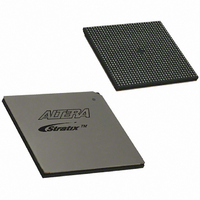EP1S40B956C5 Altera, EP1S40B956C5 Datasheet - Page 598

EP1S40B956C5
Manufacturer Part Number
EP1S40B956C5
Description
IC STRATIX FPGA 40K LE 956-BGA
Manufacturer
Altera
Series
Stratix®r
Datasheet
1.EP1S10F484I6N.pdf
(864 pages)
Specifications of EP1S40B956C5
Number Of Logic Elements/cells
41250
Number Of Labs/clbs
4125
Total Ram Bits
3423744
Number Of I /o
683
Voltage - Supply
1.425 V ~ 1.575 V
Mounting Type
Surface Mount
Operating Temperature
0°C ~ 85°C
Package / Case
956-BGA
Lead Free Status / RoHS Status
Contains lead / RoHS non-compliant
Number Of Gates
-
Available stocks
Company
Part Number
Manufacturer
Quantity
Price
Part Number:
EP1S40B956C5
Manufacturer:
ALTERA/阿尔特拉
Quantity:
20 000
- Current page: 598 of 864
- Download datasheet (11Mb)
Finite Impulse Response (FIR) Filters
7–20
Stratix Device Handbook, Volume 2
Table 7–9. Decomposition of a 16-Tap Interpolating Filter into Four Polyphase Filters
Output Sample
y(0), y(4)...
y(1), y(5)...
y(2), y(6)...
y(3), y(7)...
where:
This equation implies that the first polyphase filter, h
h(0), h(I), h(2I),..., h((P-1)I). The second polyphase filter, h
coefficients h(1), h(1+I), h(1+2I), ..., h(1+(P-1)I). Continuing in this way,
the last polyphase filter, hI
- 1) + 2I), ..., h((I - 1) + (P-1)I).
An example helps in understanding the polyphase implementation of
interpolation. Consider the polyphase representation of a 16-tap low pass
filter with an interpolation factor of 4. Thus, the output is given below:
Referring back to
the input are x(0), x(4), x(8,) and x(12). The first output, y(0), only depends
on h(0), h(4), h(8) and h(12) because x(i) is zero for i 0, 4, 8, 12.
shows the coefficients required to generate output samples.
Table 7–9
parallel polyphase filters. This is shown in
the filters are multiplexed to generate the overall output. The multiplexer
is controlled by a counter, which counts up modulo-I starting at 0.
It is illuminating to compare the computational requirements of the direct
implementation versus polyphase implementation of the low pass filter.
In the direct implementation, the number of computations per cycle
k = 0,1, …, I-1
n = 0,1, …, P-1
P = L/I = length of polyphase filters
L = length of the filter (selected to be a multiple of I)
I = interpolation factor
h(n) = original filter impulse response
y n
Coefficients Required
h(2), h(6), h(10), h(14)
h(3), h(7), h(11), h(15)
shows that this filter operation can be represented by four
h(0), h(4), h(8), h(12)
h(1), h(5), h(9), h(13)
=
i
15
=
0
h n iI
Figure 7–11 on page
–
x i
-1
(n), has coefficients h(I-1), h((I - 1) + N), h((I
Polyphase Filter Impulse Response
7–19, the only nonzero samples of
Figure
7–12. The outputs from
h
h
h
h
0
1
2
3
0
(n)
(n)
(n)
(n)
(n), has coefficients
Altera Corporation
September 2004
1
(n), has
Table 7–9
Related parts for EP1S40B956C5
Image
Part Number
Description
Manufacturer
Datasheet
Request
R

Part Number:
Description:
CYCLONE II STARTER KIT EP2C20N
Manufacturer:
Altera
Datasheet:

Part Number:
Description:
CPLD, EP610 Family, ECMOS Process, 300 Gates, 16 Macro Cells, 16 Reg., 16 User I/Os, 5V Supply, 35 Speed Grade, 24DIP
Manufacturer:
Altera Corporation
Datasheet:

Part Number:
Description:
CPLD, EP610 Family, ECMOS Process, 300 Gates, 16 Macro Cells, 16 Reg., 16 User I/Os, 5V Supply, 15 Speed Grade, 24DIP
Manufacturer:
Altera Corporation
Datasheet:

Part Number:
Description:
Manufacturer:
Altera Corporation
Datasheet:

Part Number:
Description:
CPLD, EP610 Family, ECMOS Process, 300 Gates, 16 Macro Cells, 16 Reg., 16 User I/Os, 5V Supply, 30 Speed Grade, 24DIP
Manufacturer:
Altera Corporation
Datasheet:

Part Number:
Description:
High-performance, low-power erasable programmable logic devices with 8 macrocells, 10ns
Manufacturer:
Altera Corporation
Datasheet:

Part Number:
Description:
High-performance, low-power erasable programmable logic devices with 8 macrocells, 7ns
Manufacturer:
Altera Corporation
Datasheet:

Part Number:
Description:
Classic EPLD
Manufacturer:
Altera Corporation
Datasheet:

Part Number:
Description:
High-performance, low-power erasable programmable logic devices with 8 macrocells, 10ns
Manufacturer:
Altera Corporation
Datasheet:

Part Number:
Description:
Manufacturer:
Altera Corporation
Datasheet:

Part Number:
Description:
Manufacturer:
Altera Corporation
Datasheet:

Part Number:
Description:
Manufacturer:
Altera Corporation
Datasheet:

Part Number:
Description:
CPLD, EP610 Family, ECMOS Process, 300 Gates, 16 Macro Cells, 16 Reg., 16 User I/Os, 5V Supply, 25 Speed Grade, 24DIP
Manufacturer:
Altera Corporation
Datasheet:












